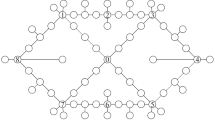Abstract
The expansion of telecommunication services has increased the number of users sharing network resources. When a given service is highly demanded, some demands may be unmet due to the limited capacity of the network links. Moreover, for such demands, telecommunication operators should pay penalty costs. To avoid rejecting demands, we can install more capacities in the existing network. In this paper we report experiments on the network capacity design for uncertain demand in telecommunication networks with integer link capacities. We use Poisson demands with bandwidths given by normal or log-normal distribution functions. The expectation function is evaluated using a predetermined set of realizations of the random parameter. We model this problem as a two-stage mixed integer program, which is solved using a stochastic subgradient procedure, the Barahona's volume approach and the Benders decomposition.
Similar content being viewed by others
References
F. Barahona and R. Anbil, “The volume algorithm: Producing primal solutions with a subgradient method,” Mathematical Programming, vol. 87, pp. 385–399, 2000.
M. Bonatti, A. Gaivoronski, P. Lemonche, and P. Polese, “Summary of some traffic engineering studies carried out within RACE project R1044,” ETT, vol. 5, no. 2, pp. 79–90, 1994.
P. Chardaire and A. Lisser, “Simplex and interior point specialization algorithms for solving non-oriented multicommodity flow problems,” Operations Research, vol. 50, no. 2, pp. 260–276, 2002.
CPLEX 8.1 User's Manual c. ILOG CPLEX Division, France, 2002.
Y. Ermoliev and R.J.-B Wets (Eds.), Numerical Techniques for Stochastic Optimization, Springer: Berlin, 1988.
F. Fantauzzi, A. Gaivoronski, and E. Messina, “Decomposition methods for network optimization problems in the presence of uncertainty,” in Network Optimization, Lecture Notes in Economics and Mathematical Systems 450, P. Pardalos, D. Hearn, and W. Hager (Eds.), Springer: Berlin, 1997, pp. 234–248.
A. Gaivoronski, “Stochastic programming approach to the network planning under uncertainty,” in Optimization in Industry 3: Mathematical Programming and Modeling Techniques in Practice, A. Sciomachen (Ed.), Wiley and Sons, 1995, pp. 145–163.
G. Infanger, “Monte Carlo (importance) sampling within a Benders decomposition algorithm for stochastic linear programs,” Annals of Operations Research, vol. 39, pp. 69–95, 1992.
A. Lisser, A. Ouorou, J.-Ph. Vial, and J. Gondzio, “Capacity Planning under uncertain demand in telecommunication networks,” France Telecom Technical Report, FTR&D, France, 1999.
M. Nabe and M.M.H. Miyahara, “Analysis and modeling of world wide web traffic for capacity dimensioning of internet access lines,” Performance Evaluation, vol. 34, pp. 249–271, 1998.
Y. Nesterov and J.-Ph. Vial, “Confidence level solutions for stochastic programming,” Logilab Technical Report, Department of Management Studies, University of Geneva, Switzerland, 2000.
S. Sen, R.D. Doverspike, and S. Cosares, “Network planning with random demand,” Telecommunication Systems, vol. 3, pp. 11–30, 1994.
Author information
Authors and Affiliations
Rights and permissions
About this article
Cite this article
Andrade, R., Lisser, A., Maculan, N. et al. Telecommunication Network Capacity Design for Uncertain Demand. Computational Optimization and Applications 29, 127–146 (2004). https://doi.org/10.1023/B:COAP.0000042027.65400.b3
Issue Date:
DOI: https://doi.org/10.1023/B:COAP.0000042027.65400.b3




